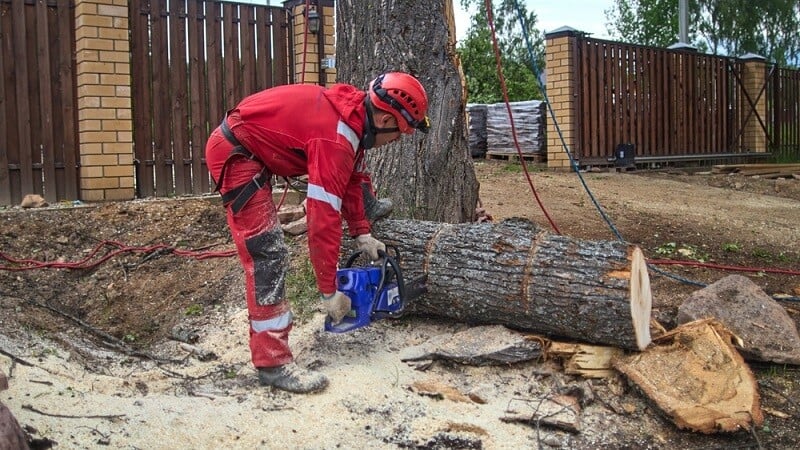Arborism is a rewarding field that grows with each seed, sapling, and shrub your neighbors plant—but how can you cut your own path through the industry?
Ultimately, learning how to start tree-cutting businesses begins with understanding what you need to research and accomplish before setting up shop.
If you’re wondering how to start tree removal businesses in your area, we have the answers you need.
Understanding the tree removal business
Before we get into how to start tree removal business services, let’s review a few key tree service industry details to build your knowledge.
Overview of tree removal services
A tree service company doesn’t just dig up stumps or lop off overhanging branches. They can be called on by property owners and managers to provide:
- Tree removal
- Emergency tree care
- Pruning and tree trimming
- Cabling and bracing to support branches with weak attachments
- Planting, plant health care, and preventive maintenance
- Soil aeration for better root growth
- Stump grinding/tree stump removal
Services are often related to safety issues rather than aesthetic choices. Arborism is also a form of property maintenance focused on preventing damage to nearby buildings or trees themselves.
Why tree removal is a growing industry
As of 2024, over 144,000 registered tree trimmers are employing nearly 300,000 people across the United States. The market expands by nearly 6% annually and is currently worth over $35 billion.
You’re not the only one researching how to start tree removal businesses. For small business owners and employees, tree removal offers:
- Dynamic work environments
- Time spent outdoors in nature
- Profit—particularly for companies with expansive services
People need trees to live, yet they can interfere with our daily lives when they grow too large or die. Arborists balance our need for oxygen with public safety and, as long as there are trees, there will likewise be a demand for tree-cutting services.
Key steps to starting your tree removal business
Let’s take a look at how to start tree-cutting business with these steps:
Step 1: Get certified as an arborist
To trim trees, you’ll have to become a certified arborist—a profession that tends to be backed by abundant practical experience. Certification tells homeowners and property managers that you’re knowledgeable about tree care, including topics deemed necessary by the International Society of Arboriculture (ISA) like:
- Tree biology
- Diagnosis
- Maintenance practices
- Safety
Maintaining certification requires ongoing professional education. You’ll have to take a course every once in a while to stay updated on arboriculture developments and techniques. Certification can also be necessary to obtain requisite licensing, business funding, and insurance.
Contact the ISA or the Tree Care Industry Association (TCIA) to pursue training, certification, and optional advanced qualifications.
Step 2: Build your business identity
Your tree service business identity, or brand, is how you help potential clients recognize and remember you. It’s often a mix of text, graphics, and style elements that cover:
- Your small business name
- A logo
- Your value proposition
Branding is essential in small markets. It separates you from similar local businesses and keeps you on the top of your neighbors’’ minds.
Step 3: Write your business plan
A viable business plan is critical if you seek any outside financing—but it’s also an important way to come up with a documented framework for your small, local tree service business. It should outline your:
- Business goals and structure
- Services offered
- Pricing options
- Financial plan
- Competitive analysis
As you draft your plans, identify which expenses are critical during start-up and which can be added as your local tree service business grows. Be sure to consider:
- Equipment such as chainsaws, stump grinders, safety gear, and transportation
- Crew members and their salaries, benefits, taxes, training, and liability costs
- Business management tools and software for scheduling, invoicing, payroll, and similar tasks
An early financial analysis is key to starting your local business as it tells you whether you have the funds to become fully operational.
Step 4: Secure financing
Budget for startup costs, including equipment, insurance, marketing, and labor, if you plan to hire workers immediately. Financing options include:
- Loans
- Grants
- Personal savings
Seek out lending options with low rates and favorable terms if you plan to take out a loan—then, plan to pay it back as soon as possible to avoid excess interest.
Obtain licenses and insurance
Tree removal is highly rewarding, but can also be a touch more dangerous than other professions. That means you’ll pay a bit more for certain premiums in addition to the required licensing. Look into:
- Business registration through a Limited Liability Company (LLC), sole proprietorship, or other ownership forms
- Tree removal and/or contractor licensing at required state and city levels
- Permit requirements within your service area
- Liability insurance
- Worker’s compensation insurance coverage
- Unemployment (and paid leave) taxes from your state’s Department of Employment
The exact insurance packages and tree service license you’ll require depend on your state, county, or even city regulations. Conduct local research to find out what you need to operate legally.
Marketing your tree removal business
Before you can lock in customers, you need to find them and help them find you. The internet is the best place to start. After all, webpages aren’t just for online-only brands and huge companies—even small neighborhood businesses need a digital presence to draw in customers.
With that in mind, make sure you have:
- A simple website with useful information
- Before-and-after pictures of your services
- A free Nextdoor Business Page
- Your business page claimed on Google
Once you have a site or account to steer the potential customer toward, leverage online and social advertising like retired teacher-turned-electrician Bill Evans does. Bill finds 50–60% of his customers through Nextdoor Ads Manager—and that’s off just one post he made!
Other talented Nextdoor users, such as artist Yi Cheng, have converted their success on the platform into coverage on other sites and publications—further elevating their status and local reputation.
Grow your tree removal business with Nextdoor
Now that you know how to start tree removal businesses, you can see why it’s essential to integrate Nextdoor into your marketing plan. For local businesses, Nextdoor is the top network for reaching any potential customer who is actively searching for your tree removal services.
Start with a free Business Page to meet your neighbors. Then, use Business Posts to interact with your community, Nextdoor Ads to find potential customers and promote special offers, and Nextdoor Ads Manager to set up and track campaigns with ease.
Stop dreaming of cutting trees and start climbing the arborist ladder. Use Nextdoor Business to grow your small, local brand today.
Sources:
- International Society of Arboriculture. Why Hire an Arborist? https://www.treesaregood.org/treeowner/whyhireanarborist
- IBISWorld. Tree Trimming Services in the US - Market Research Report (2014-2029). https://www.ibisworld.com/united-states/market-research-reports/tree-trimming-services-industry/
- International Society of Arboriculture. Which ISA Credential is Right for You? https://www.isa-arbor.com/Credentials/Which-Credential-is-Right-for-You
- Tree Care Industry Association. CTSP and Qualifications. https://treecareindustryassociation.org/education/#qualifications-credentials







